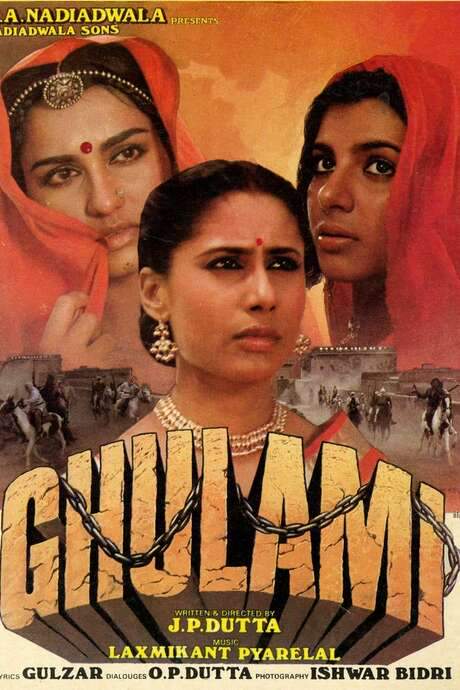
Ghulami
Year: 1985
Runtime: 171 mins
Language: Hindi
Director: J. P. Dutta
Set in the border town of Fatehpur on the India‑Pakistan frontier, the story follows Ranjit Singh Choudhary, a young man branded a rebel by his schoolmaster and by his father’s employer, Bade Thakur. Unwilling to accept the exploitation of his father’s generation, who have become economic slaves to the upper‑caste Thakurs that lend them money, Ranjit confronts the systemic injustice and fights for his fellow farmers.
Warning: spoilers below!
Haven’t seen Ghulami yet? This summary contains major spoilers. Bookmark the page, watch the movie, and come back for the full breakdown. If you're ready, scroll on and relive the story!
Ghulami (1985) – Full Plot Summary & Ending Explained
Read the complete plot breakdown of Ghulami (1985), including all key story events, major twists, and the ending explained in detail. Discover what really happened—and what it all means.
Ranjit Singh Chaudhary, portrayed by [Dharmendra], grows up in a Rajasthan village where a powerful zamindar family and a rigid caste order shape every facet of life. The peasants toil hard on the land, while the landlord’s clan commands authority over land, education, and justice, perpetuating a cycle of exploitation. In school, Ranjit’s rebellious spirit clashes with deep-rooted caste prejudices, earning him trouble as the landlord’s two sons, who are roughly his own age, bully him. Two sympathetic girls—the daughter of the school-master and the sister of the bully—offer him a glimmer of hope, hinting at connections beyond the village’s rigid rules. Frustrated by the injustice around him, Ranjit ultimately runs away to the city, seeking a path that might break the cycle of oppression.
Years pass. Ranjit’s father dies, and a telegram summons him back to the village to perform the last rites. He returns to a landscape that has changed little, only to learn that his father had borrowed money from the landlord to pay for medicines and healthcare. Now the landlord demands repayment, threatening to seize Ranjit’s lands and home—the collateral for the loan. Ranjit voices a stark, unflinching logic: the peasants till the land for generations while the landowners do little work, so if the landlord lent money to a peasant, the loan should not automatically be repaid; this belief is laid bare in a long, emotional monologue that lays bare the fault lines of class and power.
This realization catalyzes a burgeoning class conflict. Ranjit storms into the landlord’s living room, denouncing him and his ancestors as blood-suckers and challenging the legitimacy of their accumulated wealth. The landlord’s daughter, listening behind a door, is deeply moved by the confrontation and the raw honesty of Ranjit’s stance. Ranjit returns home to bury his father and forges a bond with Moran, a fellow local who becomes an ally in the struggle that is about to intensify. The stage is set for a love triangle and a broader revolutionary vendetta, as personal passions intersect with political outrage.
The romantic tension is resolved swiftly in a sequence of brutal events: the landlord’s sons attempt to rape Moran, but Ranjit intervenes, saving her and marrying Moran, who has clearly needed a protector. Sumitra Sultan Singh, who has cherished an unrequited love for Ranjit, is eventually pressed into an arranged marriage with a police officer chosen by her father. This husband—Fatehpur’s Thanedar, a man tasked with maintaining order—discovers Sumitra’s past affections and, inflamed by jealousy, aligns with his two brothers-in-law in a bid to eliminate Ranjit. What follows is a violent arc of confrontations and retaliations, with Ranjit becoming a fugitive, chased by the law and by those who would preserve the old order.
Throughout the conflict, Ranjit is supported by Jabhar, a villager who has returned from military service, and by Havaldar Gopi Dada, the village police officer whose own son was murdered by the landlord’s henchmen on his wedding day, a personal wound that fuels his complicity in the revolt. Mithun Chakraborty brings Jabhar to life, while Kulbhushan Kharbanda embodies Havaldar Gopi Dada, lending grit and resolve to the insurgent effort. The plot darkens into a cascade of bloodletting, as both sides suffer losses.
The film’s climax is stark and uncompromising: most of the principal players fall in the violence that erupts when old hierarchies refuse to yield. Yet the final note is clear—the brutal cycle of oppression persists even as rebels die for their cause. Told with a steady, even-handed tone, the narrative underscores a harsh reality: changing a centuries-old system is brutal, costly, and rarely fully victorious, even as individual courage and solidarity shine through.
The storytelling is carried by a guiding voice, with Amitabh Bachchan serving as the narrator, lending a calm, authoritative cadence that anchors the emotional and political stakes of the tale. The film’s themes—the clash of caste, the ethics of land and labor, and the human cost of rebellion—unfold through a grounded, human lens, balancing intimate relationships with sweeping social critique.
Last Updated: October 09, 2025 at 14:41
Unlock the Full Story of Ghulami
Don't stop at just watching — explore Ghulami in full detail. From the complete plot summary and scene-by-scene timeline to character breakdowns, thematic analysis, and a deep dive into the ending — every page helps you truly understand what Ghulami is all about. Plus, discover what's next after the movie.
Ghulami Timeline
Track the full timeline of Ghulami with every major event arranged chronologically. Perfect for decoding non-linear storytelling, flashbacks, or parallel narratives with a clear scene-by-scene breakdown.



